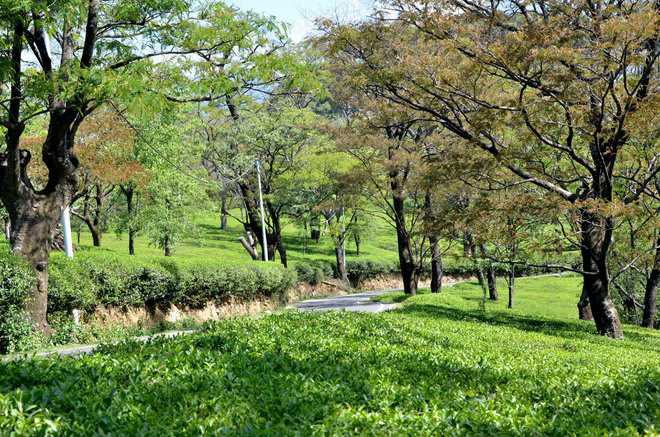
A tea garden in Dharamsala. Photo: Kamaljeet
Lalit Mohan
Tribune News Service
Dharamsala, January 19
Tea farmers of Kangra district are likely to face heavy losses due to prolonged dry spell in the region. The Dharamsala region considered one of the wettest area in the country is waiting for rain and snow. The area did not experience rainfall since December 12 and crops in most of the rainfed areas have already been damaged.
KG Butail, a leading tea farmer of Kangra, said due to the prolonged dry spell about 50 per cent damage had already been done to the tea crop. The tea crop requires moisture in the soil and air for a good output. Due to prolonged dry spell the first yield of tea leaves that is plucked around March are likely to be damaged. The state government should bring out a policy to protect the tea farmers of Kangra, he said.
AK Sarial, VC of Palampur Agriculture University, said that dry spell had caused considerable damage to the wheat crop in the lower Himachal region. Farmers in the region had sown wheat after rain on December 12. The crop required first irrigation after 21 days. However, now it is over 35 days since the first rain. The studies have indicated that first irrigation was very important for the wheat crop. Now that no irritation was available for the crop in the rainfed areas, the crop is likely to suffer heavy damages.
The VC further said lesser snow this year could give rise to more problems in the coming months as in Kangra district most of the irrigation takes place through kuhls (drains) that are fed by snow melting from hills. In case the snow was less the farmers might face problems, he said.
The farmers in Kangra district are facing drought-like situation due to lack of rain and snow in Dhauladhar mountain ranges for the past more than a month now. Most of the agriculture in Kangra district is rainfed.
The worst affected are the Changar area farmers. Changar areas of Kangra district are water deficient and mostly dependent on rain for irrigation.
Kuldeep, a farmer from the Changar near Jawalamukhi area, said they had lost even their seeds due to lack of rain. The farmers had sown wheat crop in December with the expectation of rain. However, in the absence of rain the seed is unlikely to germinate. The farmers would have to again sow the seed in case there was rain in January, he said.
The farmers in Dharamsala, Kangra and Palampur areas are dependent on kuhls for irrigation. The kuhls are water drains sources from perennial rivers in the valley. Water in these drains flows by gravity and irrigate fields. However, the water discharge in the rivers in Kangra valley was very low this year. Due to low water discharge in rivers there was no water in irrigation kuhls.
Most of the rivers of Kangra valley get water from the rains or snow melt in the Dhauladhar mountain range. This year due to prolonged dry spell most of the glaciers that were perennial sources of water to the rivers flowing through the Kangra valley have vanished.
According to RS Rana, a trekker who has been trekking through the Dhauladhar mountain range for the past more than four decades, said that it was for the first time that almost all the glaciers on the front side of the mountains had vanished.
In lower areas of Kangra valley, including areas in Nurpur, Indora and Dehra sub divisions, most of the agriculture was rainfed though some horticulturists in Nurpur and Indora area have their tubewells for irrigation. Shah Canal was the only canal irrigation project of the state that carries water of the Beas to Indora and Nurpur areas. However, since its tail end canal system was not complete it is of not much use to the farmers.
Considerable damage: VC
- AK Sarial, VC of Palampur Agriculture University, said that dry spell had caused considerable damage to the wheat crop in the lower Himachal region.
- Farmers had sown wheat after rains on December 12. The crop required first irrigation after 21 days.
- However, now it is over 35 days since the first rain.
- Now that no irritation is available for crop, the crop is likely to suffer heavy damages.



























